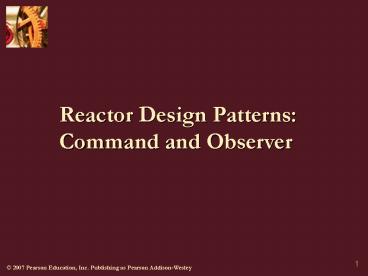Reactor Design Patterns: Command and Observer - PowerPoint PPT Presentation
Title:
Reactor Design Patterns: Command and Observer
Description:
Reactor Design Patterns: Command and Observer Objectives To present the structure, behavior, and characteristics of reactor patterns To compare and contrast the uses ... – PowerPoint PPT presentation
Number of Views:172
Avg rating:3.0/5.0
Title: Reactor Design Patterns: Command and Observer
1
Reactor Design Patterns Command and Observer
2
Objectives
- To present the structure, behavior, and
characteristics of reactor patterns - To compare and contrast the uses of reactor
patterns and event-driven architectures in
event-driven design - To present the Command pattern
- To present the Observer pattern
3
Topics
- Event-driven design
- Reactor patterns
- Function objects
- The Command pattern
- The Observer pattern
4
Event-Driven Design
- Event-driven design is an approach to program
design that focuses on events to which a program
must react. - An event is a significant occurrence
- Contrasts with stepwise refinement
- Event handlers are components that react to or
respond to events. - Reactor patterns assist in event-driven design.
5
Reactor Pattern Structure
The Client must access the Target and the Reactor
so it can register the Reactor with the Target.
6
Behavioral Phases
- Setup PhaseThe Client registers the Reactor with
the Target. - Client interacts with the Target
- Operational PhaseThe Reactor responds to events
in the Target on behalf of the Client. - Client is not involved
7
Reactor Pattern Behavior
8
Reactor Pattern Advantages
- Client and Target DecouplingOnce the client
registers the reactor with the target, the client
and target need not interact again. - Low Reactor and Target CouplingThe target only
knows that the reactor is a receiver of event
notifications. - Client DecompositionThe reactor takes over
client responsibilities for reacting to target
events. - Operation EncapsulationThe event handler in a
reactor is an encapsulated operation that can be
invoked in other ways for other reasons.
9
Event-Driven Architectures vs. Reactor Patterns
- Commonalities
- Support event-driven design
- Event announcement and handling
- Two-phase behavior
- Differences
- Level of abstraction
- Event dispatcher completely decouples targets and
reactors - Event dispatchers are complex and harder to use
- Event dispatch may damage performance
10
Function Objects
- In some languages operations can be treated as
values (stored, passed, etc.). - This is not usually true in object-oriented
languagesuse objects to encapsulate operations.
A function object or functor is an object that
encapsulates an operation the encapsulating
class is a function class.
11
Function Object Example 1
12
Function Object Example 2
Collection sortCollection new ArrayList() sortCollection.add( new InsertionSort() ) sortCollection.add( new BubbleSort() ) ... print "Sort Time1 Time2 Time3 ... Timek" for each element sorter of sortCollection print sorter.toString() for each array a startTime now() sorter.sort(a) endTime now() print( endTime startTime ) printline
13
Function Object Advantages
- Additional features can be added to the function
class besides the encapsulated operation. - The function class can include operations and
data that the encapsulated operation needs.
14
The Command Patterns
- The reactor is a function object
- Simple and very widely used way to implement
callback functions in user interfaces - Analogy emergency phone number card
15
Command Pattern Structure
16
Command Pattern Behavior
17
Command Pattern Example
18
When to Use the Command Pattern
- Use the Command pattern to delegate a clients
response to events from an invoker class to
another class that encapsulates the reaction. - Use the Command pattern to decompose clients,
lower coupling between clients and invokers, and
to encapsulate event-handling code.
19
The Observer Pattern
- Reduces coupling between classes while preserving
their ability to interact - Can be used whenever one or more objects
(observers) must react to events in another
object (subject) - Analogy current awareness service
20
Observer in the MVC Architecture
- A model in an MVC architecture can keep track of
its views and controller - Strongly couples the model to its views and
controllers - Changing the UI forces changes in the model
- The model can be a subject and the views and
controllers can be observers - Decouples the model from its views and
controllers - Changing the UI has no effect on the model
21
Subject and Observer Operations
- Subject
- Registration operations
- Notification control operations
- Query operations
- Observer
- Notification operation
22
Observer Pattern Structure
23
Observer Pattern Behavior
24
Observer Pattern Example
25
When to Use the Observer Pattern
- Use the Observer pattern whenever one object must
react to changes in another object, especially if
the objects must be loosely coupled. - User interface components
- Clock-driven components
- The main drawback of the Observer pattern is that
notification may be expensive. - This can be dealt with in several ways depending
on the situation.
26
Summary 1
- Reactor patterns use a Reactor to which a Client
delegates responsibility for responding to events
in a Target. - Reactor patterns help realize event-driven
designs in a cheaper and easier way than
event-driven architectures at the expense of
slightly higher component coupling. - The reactor patterns help decouple targets from
their both clients and reactors.
27
Summary 2
- The Command pattern uses a function object as a
reactor the function object encapsulates the
reaction and can be used for other purposes as
well. - The Observer pattern has a subject with which
observers register the subject then notifies its
observers of changes, and the observers query to
subject to determine how to react.































